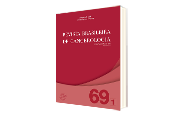Factors Associated with Karnofsky Performance Status and its Trajectory in the Last Month of Life in Patients with Terminal Cancer
DOI:
https://doi.org/10.32635/2176-9745.RBC.2023v69n1.2754Keywords:
Karnofsky performance status, neoplasms, terminally Ill, palliative care, prognosisAbstract
Introduction: Karnofsky Performance Status (KPS) can characterize the impact of the disease on cancer patients. Objective: To evaluate the factors associated with KPS and its trajectory in the last month of life in patients with terminal cancer. Method: Retrospective cohort study, with terminal cancer patients enrolled in a Palliative Care Unit, who died between July and August 2019. The dependent variable was the KPS assessed daily in the last month of life. A cross-sectional analysis of factors associated with initial KPS was performed using ordinal logistic regressions. To verify the trajectory of KPS in the last month of life, longitudinal graphic analyzes were performed. Results: 108 patients were evaluated, most of whom were >60 years old (68.5%) and female (62.0%). The most prevalent tumor sites were the gastrointestinal tract (GIT) (24.3%), breast (18.7%) and head and neck (HN) (16.8%). In the multiple model, the primary tumor sites remained associated with KPS. During the last month of life, the reduction in KPS was more pronounced in those with tumors in the GIT, HN and connective bone tissue, who had higher KPS values on the thirtieth day before death when compared to the others. On the other hand, those with central nervous system and lung cancer started the follow-up period with lower KPS values and had a less exacerbated reduction than the others. Conclusion: KPS values decrease in the last month of life, but with different intensity according to the tumor site in patients with terminal cancer.
Downloads
References
Neeman E, Gresham G, Ovasapians M, et al. Comparing physician and nurse Eastern Cooperative Oncology Group Performance Status (ECOG-PS) ratings as predictors of clinical outcomes in patients with cancer. Oncologist. 2019;24(12):e1460-e6. doi: https://doi.org/10.1634/theoncologist.2018-0882 DOI: https://doi.org/10.1634/theoncologist.2018-0882
Sanvezzo VMS, Montandon DS, Esteves LSF. Instrumentos de avaliação de funcionalidade de idosos em cuidados paliativos: uma revisão integrativa. Rev Bras Geriatr Gerontol. 2018;21(5):627-38. doi: https://doi.org/10.1590/1981-22562018021.180033 DOI: https://doi.org/10.1590/1981-22562018021.180033
Pereira EEB, Santos NB, Sarges ESNF. Avaliação da capacidade funcional do paciente oncogeriátrico hospitalizado. Rev Pan-Amaz Saude. 2014;5(4):37-44. doi: https://doi.org/10.5123/S2176-62232014000400005 DOI: https://doi.org/10.5123/S2176-62232014000400005
Karnofsky DA, Burchenal JH. The clinical evaluation of chemotherapeutic agents in cancer. In: Macleod CM. Evaluation of chemotherapeutic agents. New York: Columbia Univ Press; 1949. p. 191-205.
Rosa KSC, Oliveira AS, Cypriano RP. Prognostic factors in inpatients with advanced cancer at a palliative care unit. Braz J Oncol. 2022;18:e-20220344. doi: https://doi.org/10.5935/2526-8732.20220344 DOI: https://doi.org/10.5935/2526-8732.20220344
PG-SGA/Pt-Plataforma Global [Internet]. Vernon Hills: Pt-Global; c2014 – [cited 2022 Feb 2]. Available from: https://pt-global.org/
Ottery FD. Definition of standardized nutritional assessment and interventional pathways in oncology. Nutrition. 1996;12(1 Suppl):S15-9. doi: https://doi.org/10.1016/0899-9007(96)90011-8 DOI: https://doi.org/10.1016/0899-9007(95)00067-4
Chow R, Bruera E, Temel JS, et al. Inter-rater reliability in performance status assessment among healthcare professionals: an updated systematic review and meta-analysis. Support Care Cancer. 2020;28(5):2071-8. doi: https://doi.org/10.1007/s00520-019-05261-7 DOI: https://doi.org/10.1007/s00520-019-05261-7
Perez-Cruz PE, Shamieh O, Paiva CE, et al. Factors associated with attrition in a multicenter longitudinal observational study of patients with advanced cancer. J Pain Symptom Manage. 2018;55(3):938-45. doi: https://doi.org/10.1016/j.jpainsymman.2017.11.009 DOI: https://doi.org/10.1016/j.jpainsymman.2017.11.009
Lampert MA, Billing AE, Onófrio LF, et al. Adequação terapêutica: apresentação de um protocolo hospitalar. Rev Bioét. 2022;30(1):94-105. doi: https://doi.org/10.1590/1983-80422022301510PT DOI: https://doi.org/10.1590/1983-80422022301510en
Hui D, Paiva CE, Del Fabro EG, et al. Prognostication in advanced cancer: update and directions for future research. Support Care Cancer. 2019;27(6):1973-84. doi: https://doi.org/10.1007/s00520-019-04727-y DOI: https://doi.org/10.1007/s00520-019-04727-y
Mori M, Morita T, Bruera E, et al. Prognostication of the last days of life. Cancer Res Treat. 2022;54(3):631-43. doi: https://doi.org/10.4143/crt.2021.1573 DOI: https://doi.org/10.4143/crt.2021.1573
Jang RW, Caraiscos VB, Swami N, et al. Simple prognostic model for patients with advanced cancer based on performance status. J Oncol Pract. 2014;10(5):e335-41. doi: https://doi.org/10.1200/JOP.2014.001457 DOI: https://doi.org/10.1200/JOP.2014.001457
Rosa KSC, Cyipriano RP, Albuquerque NM, et al. Predictive factors of death on hospitalization in patients with advanced cancer in palliative care. Am J Hosp Palliat Care. 2021;38(10):1189-94. doi: https://doi.org/10.1177/1049909120976398 DOI: https://doi.org/10.1177/1049909120976398
Yang J, Peng A, Wang B, et al. The prognostic impact of lymph node metastasis in patients with non-small cell lung cancer and distant organ metastasis. Clin Exp Metastasis. 2019;36(5):457-66. doi: https://doi.org/10.1007/s10585-019-09985-y DOI: https://doi.org/10.1007/s10585-019-09985-y
Min Y, Liu X, Hu D, et al. Risk factors, prognostic factors, and nomogram for distant metastasis in breast cancer patients without lymph node metastasis. Front Endocrinol (Lausanne). 2021;12:771226. doi: https://doi.org/10.3389/fendo.2021.771226 DOI: https://doi.org/10.3389/fendo.2021.771226
Santos I, Mendes L, Mansinho H, et al. Nutritional status and functional status of the pancreatic cancer patients and the impact of adjacent symptoms. Clin Nutr. 2021;40(11):5486-93. doi: https://doi.org/10.1016/j.clnu.2021.09.019 DOI: https://doi.org/10.1016/j.clnu.2021.09.019
Valle TD, Turrini RNT, Poveda VB. Fatores intervenientes para o início do tratamento de pacientes com câncer de estômago e colorretal. Rev Latino-Am Enfermagem. 2017;25:e2879. doi: https://doi.org/10.1590/1518-8345.1493.2879 DOI: https://doi.org/10.1590/1518-8345.1493.2879
Lee GJ, Gwak JH, Kim MS, et al. Changes in the palliative performance scale may be as important as the initial palliative performance scale for predicting survival in terminal cancer patients. Palliat Support Care. 2021;19(5):547-51. doi: https://doi.org/10.1017/S1478951520001248 DOI: https://doi.org/10.1017/S1478951520001248
Masel EK, Schur S, Nemecek R, et al. Palliative care units in lung cancer in the real-world setting: a single institution's experience and its implications. Ann Palliat Med. 2017;6(1):6-13. doi: https://doi.org/10.21037/apm.2016.08.06 DOI: https://doi.org/10.21037/apm.2016.08.06
Barz M, Gerhardt J, Bette S, et al. Prognostic value of tumour volume in patients with a poor Karnofsky performance status scale - a bicentric retrospective study. BMC Neurol. 2021;21(1):446. doi: https://doi.org/10.1186/s12883-021-02424-0 DOI: https://doi.org/10.1186/s12883-021-02424-0
Thier K, Calabek B, Tinchon A, et al. The Last 10 Days of patients with glioblastoma: assessment of clinical signs and symptoms as well as treatment. Am J Hosp Palliat Care. 2016;33(10):985-8. doi: https://doi.org/10.1177/1049909115609295 DOI: https://doi.org/10.1177/1049909115609295
Published
How to Cite
Issue
Section
License
Os direitos morais e intelectuais dos artigos pertencem aos respectivos autores, que concedem à RBC o direito de publicação.

This work is licensed under a Creative Commons Attribution 4.0 International License.





